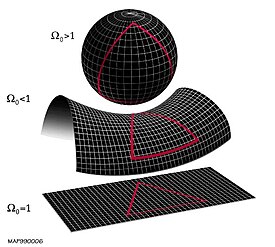While very few researchers now doubt the Big Bang occurred, the scientific community was once divided between supporters of the Big Bang and those of alternative cosmological models. Throughout the historical development of the subject, problems with the Big Bang theory were posed in the context of a scientific controversy regarding which model could best describe the cosmological observations (see the history section above). With the overwhelming consensus in the community today supporting the Big Bang model, many of these problems are remembered as being mainly of historical interest; the solutions to them have been obtained either through modifications to the theory or as the result of better observations. Other issues, such as the cuspy halo problem and the dwarf galaxy problem of cold dark matter, are not considered to be fatal as it is anticipated that they can be solved through further refinements of the theory.
The core ideas of the Big Bang—the expansion, the early hot state, the formation of helium, the formation of galaxies—are derived from many independent observations including abundance of light elements, the cosmic microwave background, large scale structure and Type Ia supernovae, and can hardly be doubted as important and real features of our universe.
Precise modern models of the Big Bang appeal to various exotic physical phenomena that have not been observed in terrestrial laboratory experiments or incorporated into the Standard Model of particle physics. Of these features, dark energy and dark matter are considered the most secure, while inflation and baryogenesis remain speculative: they provide satisfying explanations for important features of the early universe, but could be replaced by alternative ideas without affecting the rest of the theory.[notes 6] Explanations for such phenomena remain at the frontiers of inquiry in physics.
Horizon problem
The horizon problem results from the premise that information cannot travel faster than light. In a universe of finite age, this sets a limit—the particle horizon—on the separation of any two regions of space that are in causal contact.[37] The observed isotropy of the CMB is problematic in this regard: if the universe had been dominated by radiation or matter at all times up to the epoch of last scattering, the particle horizon at that time would correspond to about 2 degrees on the sky. There would then be no mechanism to cause these regions to have the same temperature.
A resolution to this apparent inconsistency is offered by inflationary theory in which a homogeneous and isotropic scalar energy field dominates the universe at some very early period (before baryogenesis). During inflation, the universe undergoes exponential expansion, and the particle horizon expands much more rapidly than previously assumed, so that regions presently on opposite sides of the observable universe are well inside each other's particle horizon. The observed isotropy of the CMB then follows from the fact that this larger region was in causal contact before the beginning of inflation.
Heisenberg's uncertainty principle predicts that during the inflationary phase there would be quantum thermal fluctuations, which would be magnified to cosmic scale. These fluctuations serve as the seeds of all current structure in the universe. Inflation predicts that the primordial fluctuations are nearly scale invariant and Gaussian, which has been accurately confirmed by measurements of the CMB.
Flatness/oldness problem

The flatness problem (also known as the oldness problem) is an observational problem associated with a Friedmann-Lemaître-Robertson-Walker metric.[37] The universe may have positive, negative or zero spatial curvature depending on its total energy density. Curvature is negative if its density is less than the critical density, positive if greater, and zero at the critical density, in which case space is said to be flat. The problem is that any small departure from the critical density grows with time, and yet the universe today remains very close to flat.[notes 7] Given that a natural timescale for departure from flatness might be the Planck time, 10−43 seconds, the fact that the universe has reached neither a Heat Death nor a Big Crunch after billions of years requires some explanation. For instance, even at the relatively late age of a few minutes (the time of nucleosynthesis), the universe must have been within one part in 1014 of the critical density, or it would not exist as it does today.[38]
A resolution to this problem is offered by inflationary theory. During the inflationary period, spacetime expanded to such an extent that its curvature would have been smoothed out. Thus, it is believed that inflation drove the universe to a very nearly spatially flat state, with almost exactly the critical density.
Magnetic monopoles
The magnetic monopole objection was raised in the late 1970s. Grand unification theories predicted topological defects in space that would manifest as magnetic monopoles. These objects would be produced efficiently in the hot early universe, resulting in a density much higher than is consistent with observations, given that searches have never found any monopoles. This problem is also resolved by cosmic inflation, which removes all point defects from the observable universe in the same way that it drives the geometry to flatness.[37]
A resolution to the horizon, flatness, and magnetic monopole problems alternative to cosmic inflation is offered by the Weyl curvature hypothesis.[39][40]
Baryon asymmetry
It is not yet understood why the universe has more matter than antimatter.[24] It is generally assumed that when the universe was young and very hot, it was in statistical equilibrium and contained equal numbers of baryons and anti-baryons. However, observations suggest that the universe, including its most distant parts, is made almost entirely of matter. An unknown process called "baryogenesis" created the asymmetry. For baryogenesis to occur, the Sakharov conditions must be satisfied. These require that baryon number is not conserved, that C-symmetry and CP-symmetry are violated and that the universe depart from thermodynamic equilibrium.[41] All these conditions occur in the Standard Model, but the effect is not strong enough to explain the present baryon asymmetry.
Globular cluster age
In the mid-1990s, observations of globular clusters appeared to be inconsistent with the Big Bang. Computer simulations that matched the observations of the stellar populations of globular clusters suggested that they were about 15 billion years old, which conflicted with the 13.7-billion-year age of the universe. This issue was generally resolved in the late 1990s when new computer simulations, which included the effects of mass loss due to stellar winds, indicated a much younger age for globular clusters.[42] There still remain some questions as to how accurately the ages of the clusters are measured, but it is clear that these objects are some of the oldest in the universe.
Dark matter

During the 1970s and 1980s, various observations showed that there is not sufficient visible matter in the universe to account for the apparent strength of gravitational forces within and between galaxies. This led to the idea that up to 90% of the matter in the universe is dark matter that does not emit light or interact with normal baryonic matter. In addition, the assumption that the universe is mostly normal matter led to predictions that were strongly inconsistent with observations. In particular, the universe today is far more lumpy and contains far less deuterium than can be accounted for without dark matter. While dark matter was initially controversial, it is now indicated by numerous observations: the anisotropies in the CMB, galaxy cluster velocity dispersions, large-scale structure distributions, gravitational lensing studies, and X-ray measurements of galaxy clusters.[43]
The evidence for dark matter comes from its gravitational influence on other matter, and no dark matter particles have been observed in laboratories. Many particle physics candidates for dark matter have been proposed, and several projects to detect them directly are underway.[44]
Dark energy
Measurements of the redshift–magnitude relation for type Ia supernovae have revealed that the expansion of the universe has been accelerating since the universe was about half its present age. To explain this acceleration, general relativity requires that much of the energy in the universe consists of a component with large negative pressure, dubbed "dark energy". Dark energy is indicated by several other lines of evidence. Measurements of the cosmic microwave background indicate that the universe is very nearly spatially flat, and therefore according to general relativity the universe must have almost exactly the critical density of mass/energy. But the mass density of the universe can be measured from its gravitational clustering, and is found to have only about 30% of the critical density.[9] Since dark energy does not cluster in the usual way it is the best explanation for the "missing" energy density. Dark energy is also required by two geometrical measures of the overall curvature of the universe, one using the frequency of gravitational lenses, and the other using the characteristic pattern of the large-scale structure as a cosmic ruler.
Negative pressure is a property of vacuum energy, but the exact nature of dark energy remains one of the great mysteries of the Big Bang. Possible candidates include a cosmological constant and quintessence. Results from the WMAP team in 2008, which combined data from the CMB and other sources, indicate that the universe today is 72% dark energy, 23% dark matter, 4.6% regular matter and less than 1% neutrinos.[21] The energy density in matter decreases with the expansion of the universe, but the dark energy density remains constant (or nearly so) as the universe expands. Therefore matter made up a larger fraction of the total energy of the universe in the past than it does today, but its fractional contribution will fall in the far future as dark energy becomes even more dominant.
In the ΛCDM, the best current model of the Big Bang, dark energy is explained by the presence of a cosmological constant in the general theory of relativity. However, the size of the constant that properly explains dark energy is surprisingly small relative to naive estimates based on ideas about quantum gravity. Distinguishing between the cosmological constant and other explanations of dark energy is an active area of current research.

Tidak ada komentar:
Posting Komentar